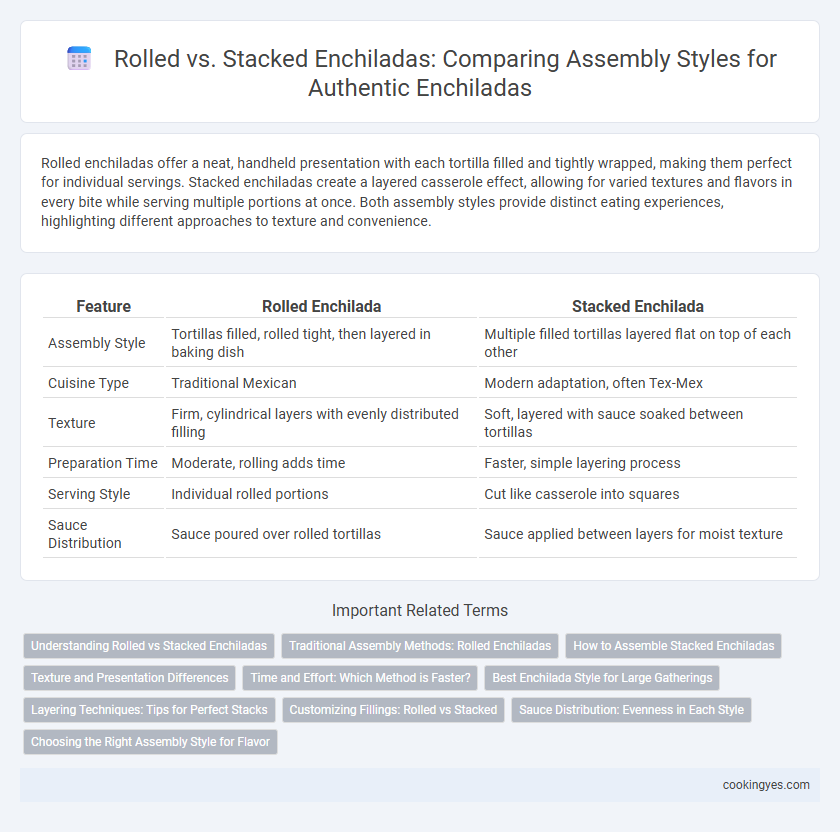Rolled enchiladas offer a neat, handheld presentation with each tortilla filled and tightly wrapped, making them perfect for individual servings. Stacked enchiladas create a layered casserole effect, allowing for varied textures and flavors in every bite while serving multiple portions at once. Both assembly styles provide distinct eating experiences, highlighting different approaches to texture and convenience.
Table of Comparison
| Feature | Rolled Enchilada | Stacked Enchilada |
|---|---|---|
| Assembly Style | Tortillas filled, rolled tight, then layered in baking dish | Multiple filled tortillas layered flat on top of each other |
| Cuisine Type | Traditional Mexican | Modern adaptation, often Tex-Mex |
| Texture | Firm, cylindrical layers with evenly distributed filling | Soft, layered with sauce soaked between tortillas |
| Preparation Time | Moderate, rolling adds time | Faster, simple layering process |
| Serving Style | Individual rolled portions | Cut like casserole into squares |
| Sauce Distribution | Sauce poured over rolled tortillas | Sauce applied between layers for moist texture |
Understanding Rolled vs Stacked Enchiladas
Rolled enchiladas feature individual tortillas filled, rolled, and placed side by side, creating distinct servings that soak evenly in sauce. Stacked enchiladas layer multiple tortillas with fillings and sauce between each, forming a casserole-like dish with a unified texture. Understanding these styles helps optimize flavor distribution and presentation in authentic Mexican cuisine.
Traditional Assembly Methods: Rolled Enchiladas
Rolled enchiladas are traditionally assembled by filling a corn tortilla with ingredients, then rolling it tightly before placing it seam-side down in a baking dish, which helps maintain structure and evenly distributes sauce and cheese. This method contrasts with stacked enchiladas, where tortillas and fillings are layered like a casserole, altering the texture and presentation. Rolled enchiladas preserve the classic Mexican culinary technique, ensuring each bite contains a balanced mix of fillings and sauce.
How to Assemble Stacked Enchiladas
To assemble stacked enchiladas, start by layering a corn tortilla on the plate, then spread a portion of seasoned meat, cheese, and sauce evenly over it. Add another tortilla on top and repeat the layering process until reaching the desired height, typically 3 to 4 layers. Finish by covering the top layer generously with enchilada sauce and shredded cheese before baking until bubbly and golden.
Texture and Presentation Differences
Rolled enchiladas offer a uniform, soft texture with a neat, cylindrical presentation that highlights the sauce and cheese melting over each individual roll. Stacked enchiladas create a layered texture combining slightly firmer edges with gooey interiors, presenting a casserole-like appearance that emphasizes volume and layered ingredients. The choice between rolled and stacked styles significantly affects mouthfeel, with rolled enchiladas providing consistent bites and stacked enchiladas delivering varied texture contrasts.
Time and Effort: Which Method is Faster?
Rolled enchiladas require individually wrapping tortillas around fillings, which can be time-consuming but allows for uniform cooking. Stacked enchiladas involve layering tortillas and fillings in a baking dish, reducing assembly time and simplifying the process. For faster preparation, stacked enchiladas typically demand less effort and are more efficient in terms of assembly time.
Best Enchilada Style for Large Gatherings
Rolled enchiladas offer a streamlined assembly process ideal for large gatherings, allowing for uniform portions and easy serving. Stacked enchiladas provide a visually impressive presentation and accommodate varied fillings, but can be more time-consuming to prepare and serve. For efficiency and consistency at scale, rolled enchiladas are the preferred style in catering large groups.
Layering Techniques: Tips for Perfect Stacks
Rolled enchiladas require careful rolling of tortillas around fillings, creating individual portions with uniform shape, while stacked enchiladas involve layering tortillas, sauce, cheese, and fillings in a casserole-style assembly. For perfect stacked enchiladas, evenly spread sauce between layers and press gently to ensure stability and moisture absorption. Using a combination of shredded cheese and sauce between each layer enhances flavor merging and helps hold the layers together during baking.
Customizing Fillings: Rolled vs Stacked
Rolled enchiladas allow for precise customization by tightly wrapping fillings like shredded chicken, cheese, and beans inside a corn tortilla, ensuring even distribution and individual portions. Stacked enchiladas layer multiple tortillas with fillings between each, offering flexibility to mix diverse ingredients such as ground beef, vegetables, and sauces across layers for a varied flavor profile. Both assembly styles cater to unique texture and taste preferences, enhancing the enchilada experience.
Sauce Distribution: Evenness in Each Style
Rolled enchiladas offer more uniform sauce distribution as the sauce is poured over each tightly wrapped tortilla, ensuring consistent moisture and flavor with each bite. Stacked enchiladas tend to have sauce primarily between layers, which can result in uneven sauce coverage, especially on the top and bottom surfaces. The rolled style maximizes even saucing by enveloping the filling and allowing the sauce to seep evenly throughout the dish.
Choosing the Right Assembly Style for Flavor
Rolled enchiladas tightly wrap fillings in corn tortillas, allowing sauces to evenly coat each bite and intensifying the blend of flavors with every mouthful. Stacked enchiladas layer tortillas and fillings similar to a casserole, offering a heartier texture and more pronounced separation of ingredients, which highlights distinct flavor profiles. Selecting the assembly style depends on whether you prefer a unified, saucy experience with rolled enchiladas or a layered, textured complexity with stacked enchiladas.
Rolled enchilada vs stacked enchilada for assembly style Infographic

 cookingyes.com
cookingyes.com